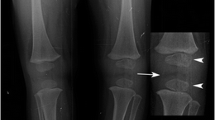Abstract
A 1-month-old boy with shortness of extremities on prenatal US was referred to our department with a provisional diagnosis of achondroplasia. His height was normal but he had short extremities and platyspondyly, premature carpal epiphyses on both hands, and short tubular bones with irregular metaphyses on radiographs. Re-evaluation of the patient at the age of 1 year revealed very short height and premature calcification of the costal cartilages and epiphyses. Spondylometaepiphyseal dysplasia (SMED), short limb-abnormal calcification type was diagnosed. This condition is a very rare autosomal recessively inherited disorder, and most of the patients die in early childhood due to neurological involvement. At the age of 2 years and 5 months, a CT scan showed narrowing of the cervical spinal canal. One month later he died suddenly because of spinal cord injury. In conclusion early diagnosis is very important because the recurrence risk is high and patients may die due to early neurological complications. The time of onset of abnormal calcifications, a diagnostic finding of the disease, is at the age of around 1 year in most patients. When abnormal calcifications are not yet present, but radiological changes associated with SMED are present, this rare disease must be considered.





Similar content being viewed by others
References
Borochowitz Z, Langer LO Jr, Gruber HE et al (1993) Spondylo-meta-epiphyseal dysplasia (SMED), short limb-hand type: a congenital familial skeletal dysplasia with distinctive features and histopathology. Am J Med Genet 45:320–326
Langer LO Jr, Wolfson BJ, Scott CI Jr et al (1993) Further delineation of spondylo-meta-epiphyseal dysplasia, short limb-abnormal calcification type, with emphasis on diagnostic features. Am J Med Genet 45:488–500
Al-Gazali LI, Bakalinova D, Sztriha L (1996) Spondylo-meta-epiphyseal dysplasia, short limb, abnormal calcification type. Clin Dysmorphol 5:197–206
Fano V, Lejarraga H, Barreiro C (2001) Spondylo-meta-epiphyseal dysplasia, short limb-abnormal calcification type: a new case with severe neurological involvement. Pediatr Radiol 31:19–22
Author information
Authors and Affiliations
Corresponding author
Rights and permissions
About this article
Cite this article
Tüysüz, B., Gazioğlu, N., Üngür, S. et al. The time of onset of abnormal calcification in spondylometaepiphyseal dysplasia, short limb-abnormal calcification type. Pediatr Radiol 39, 84–89 (2009). https://doi.org/10.1007/s00247-008-1036-1
Received:
Revised:
Accepted:
Published:
Issue Date:
DOI: https://doi.org/10.1007/s00247-008-1036-1




